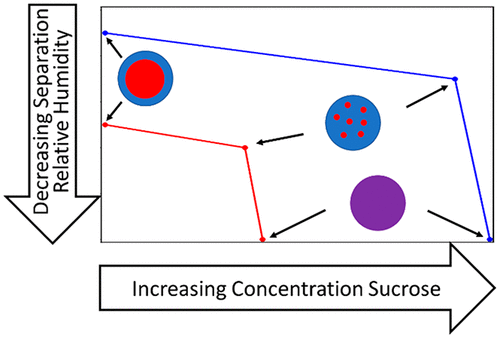当前位置:
X-MOL 学术
›
ACS Earth Space Chem.
›
论文详情
Our official English website, www.x-mol.net, welcomes your
feedback! (Note: you will need to create a separate account there.)
Effects of Sucrose on Phase Transitions of Organic/Inorganic Aerosols
ACS Earth and Space Chemistry ( IF 2.9 ) Pub Date : 2020-03-03 , DOI: 10.1021/acsearthspacechem.0c00006 Emily-Jean E. Ott 1 , Emma C. Tackman 1 , Miriam Arak Freedman 1
ACS Earth and Space Chemistry ( IF 2.9 ) Pub Date : 2020-03-03 , DOI: 10.1021/acsearthspacechem.0c00006 Emily-Jean E. Ott 1 , Emma C. Tackman 1 , Miriam Arak Freedman 1
Affiliation

|
Aerosol morphology influences the interactions of particles with light, water uptake, and heterogeneous chemistry. Through these mechanisms, morphology may be important to the role of aerosol particles on the climate system. A factor that impacts morphology is the diverse and complex mixture of organic compounds that make up the aerosol particles in the atmosphere. In this paper, we investigate the effect of sucrose on liquid–liquid phase separation. As the amount of sucrose is increased, the oxygen to carbon ratio (O:C) of the particles increases. We show that the morphology of the particle changes as O:C is increased with phase separation causing the particle to take on a textured appearance due to large or small inclusions, as opposed to a core–shell particle. As a result of the increased O:C ratio, the separation relative humidity (SRH) of the particles decreases and, in all cases, the SRH can be completely arrested with the addition of a sufficiently large concentration of sucrose. The quantity of sucrose required to arrest phase separation of the particles shows a direct correlation with the SRH of the system without sucrose. The identity of the salt also impacts the amount of sucrose required to arrest phase separation and is controlled more strongly by the identity of the anion. When the mixture contains an organic/inorganic combination that is strongly phase separating, phase separation is observed at an O:C of 0.92 which is a higher O:C value than previously shown (O:C > 0.8). Sucrose is compared with several other high O:C compounds to confirm the influence of the average O:C ratio. In all, these effects could drastically influence aerosol processes in the climate system.
中文翻译:

蔗糖对有机/无机气溶胶相变的影响
气溶胶形态会影响粒子与光,水吸收和异质化学的相互作用。通过这些机制,形态对于气溶胶颗粒在气候系统中的作用可能很重要。影响形态的一个因素是构成大气中气溶胶颗粒的有机化合物的多样性和复杂性。在本文中,我们研究了蔗糖对液相分离的影响。随着蔗糖量的增加,颗粒的氧碳比(O:C)增加。我们表明,随着O:C随着相分离的增加,颗粒的形貌发生变化,这导致颗粒由于夹杂物的大小而呈现出质感外观,这与核-壳颗粒相反。由于O:C比增加,颗粒的分离相对湿度(SRH)降低,并且在所有情况下,都可以通过添加足够高浓度的蔗糖来完全阻止SRH。阻止颗粒的相分离所需的蔗糖量与没有蔗糖的系统的SRH直接相关。盐的身份也影响阻止相分离所需的蔗糖量,并且受阴离子的身份更严格地控制。当混合物包含强相分离的有机/无机混合物时,在O:C为0.92时观察到相分离,这比以前显示的O:C值高(O:C> 0.8)。将蔗糖与其他几种高O:C化合物进行比较,以确认平均O:C比率的影响。在所有,
更新日期:2020-04-23
中文翻译:

蔗糖对有机/无机气溶胶相变的影响
气溶胶形态会影响粒子与光,水吸收和异质化学的相互作用。通过这些机制,形态对于气溶胶颗粒在气候系统中的作用可能很重要。影响形态的一个因素是构成大气中气溶胶颗粒的有机化合物的多样性和复杂性。在本文中,我们研究了蔗糖对液相分离的影响。随着蔗糖量的增加,颗粒的氧碳比(O:C)增加。我们表明,随着O:C随着相分离的增加,颗粒的形貌发生变化,这导致颗粒由于夹杂物的大小而呈现出质感外观,这与核-壳颗粒相反。由于O:C比增加,颗粒的分离相对湿度(SRH)降低,并且在所有情况下,都可以通过添加足够高浓度的蔗糖来完全阻止SRH。阻止颗粒的相分离所需的蔗糖量与没有蔗糖的系统的SRH直接相关。盐的身份也影响阻止相分离所需的蔗糖量,并且受阴离子的身份更严格地控制。当混合物包含强相分离的有机/无机混合物时,在O:C为0.92时观察到相分离,这比以前显示的O:C值高(O:C> 0.8)。将蔗糖与其他几种高O:C化合物进行比较,以确认平均O:C比率的影响。在所有,











































 京公网安备 11010802027423号
京公网安备 11010802027423号